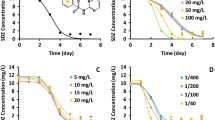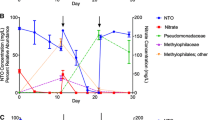Abstract
We studied the anaerobic biodegradation of hexahydro-1,3,5-trinitro-1,3,5-triazine (RDX) in a mineral medium by a mixed culture. RDX degradation activity was maintained for more than a year with only the addition of RDX. We observed a steady increase in the protein concentration of the culture from 4.8 μg mL−1 to more than 24.4 μg mL−1, a >400% increase. There was only a slight increase in protein in the RDX unamended control bottles containing live culture, increasing from 4.8 μg mL−1 to 7.8 μg mL−1. Radiolabeled 14C-RDX confirmed mineralization of the cyclic nitramine to 14CO2. After 164 days, 35% of the radiolabel was recovered as 14CO2. This is the first report demonstrating the mineralization of RDX when it serves as a growth substrate for a mixed culture.



Similar content being viewed by others
Literature Cited
Adrian NR, Arnett CM (2004) Anaerobic biodegradation of hexahydro-1,3,5-trinitro-1,3,5-triazine (RDX) by Acetobacterium malicum strain HAAP-1 isolated from a methanogenic mixed culture. Curr Microbiol 48:332–340
Adrian NR, Arnett CM, Hickey RF (2003) Stimulating the anaerobic biodegradation of explosives by the addition of hydrogen or electron donors that produce hydrogen. Water Res 37:3499–3507
Beller HR (2002) Anaerobic biotransformation of RDX (hexahydro-1,3,5-trinitro-1,3,5-triazine) by aquifer bacteria using hydrogen as the sole electron donor. Water Research 36:2533–2540
Boopathy R, Gurgas M, Ullian J, Manning JF (1998) Metabolism of explosive compounds by sulfate-reducing bacteria. Current Microbiology 37:127–131
Funk SB, Roberts DJ, Crawford DL, Crawford RL (1993) Initial-phase optimization for bioremediation of munition compound-contaminated soils. Appl Environ Microbiol 59:2171–2177
Gorontzy T, Drzyzga O, Kahl M, Bruns-Nagel D, Breitung J, von Loew E, Blotevogel K-H (1994) Microbial degradation of explosives and related compounds. Crit Rev Microbiol 20:265–284
Hawari J, Beaudet S, Halasz A, Thiboutot S, Ampleman G (2000) Microbial degradation of explosives: biotransformation versus mineralization. Appl Microbiol Biotechnol 54:605–618
Hawari J (2000) Biodegradation of RDX and HMX: From basic research to field application. In: Spain JC, Hughes JB, Knackmuss H-J (eds) Biodegradation of nitroaromatic compounds and explosives. Boca Raton: Lewis Publishers, pp 277–310
Hawari J, Halasz A, Sheremata T, Beaudet S, Groom C, Paquet L, Rhofir C, Amplemann G, Thiboutot S (2000) Characterization of metabolites during biodegradation of hexahydro-1,3,5-trinitro-1,3,5-triazine (RDX) with municipal anaerobic sludge. Appl Environ Microbiol 66:2652–2657
Kitts CL, Green CE, Otley RA, Alvarex MA, Unkefer PJ (2000) Type I nitroreductase in soil enterobacteria reduce TNT (2,4,6-trinitrotoluene) and RDX (hexahydro-1,3,5-trinitro-1,3,5-triazine). Can J Microbiol 46:278–282
Kitts CL, Cunningham DP, Unkefer PJ (1994) Isolation of three hexahydro-1,3,5-trinitro-1,3,5-triazine-degrading species of the family Enterobacteriaceae from nitramine explosive-contaminated soil. Appl Environ Microbiol 60:4608–4711
McCormick NG, Cornell JH, Kaplan AM (1981) Biodegradation of hexahydro-1,3,5-trinitro-1,3,5,-triazine. Appl Environ Microbiology 42:817–823
Oh B-T, Just CL, Alvarez PJJ (2001) Hexahydro-1,3,5-trinitro-1,3,5-triazine mineralization by zerovalent iron and mixed anaerobic cultures. Environ Sci Technol 35:4341–4346
Qazi M, Froward B, Schor M, Nelson B (1995) Pink water treatment options. Final Report ADA295802: 1–99. National Technical Information Service. Springfield, VA, USA
Speitel GE Jr, Engels TL, McKinney DC (2001) Biodegradation of RDX in unsaturated soil. Bioremediat J 5(1):1–11
Talmage SS, Opresko DM, Maxwell CJ, Welsh CJE, Cretella FM, Reno PH, Daniel RB (1999) Nitroaromatic munition compounds: environmental effects and screening values. In: Ware GW (ed) Rev Environ Contam Toxicol 161. New York: Springer, pp 1–156
US Department of Health and Human Services (1995) Toxicological profile for RDX. Agency for Toxic Substances and Disease Registry, Atlanta, GA
Young D, Kitts C, Unkefeer P, Ogden K (1997) Biotransformation of hexahydro-1,3,5-trinitro-1,3,5-triazine (RDX) by a prospective consortium and its most effective isolate Serratia marcescens. Biotech Bioeng 53:515–522
Wildman MJ, Alvarez PJJ (2001) RDX degradation using an integrated Fe(0)-microbial treatment approach. Water Sci Technol 43:25–33
Zhao J-S, Spain J, Hawari J (2003) Phylogenetic and metabolic diversity of hexahydro-1,3,5-trinitro1,3,5-triazine (RDX)-transforming bactgeira in strictly anaerobic mixed cultures enriched on RDX as nitrogen source. FEMS Microbiol Ecol 46:189–196
Zhao J-S, Paquet L, Halasz A, Hawari J (2003) Metabolism of hexahydro-1,3,5-trinitro-1,3,5-triazine through initial reduction to hexahydro-1-nitroso-3,5-dinitro-1,3,5-triazine followed by denitration in Clostridium befermaentans HAW-1. (2003) Appl Microbiol Biotechnol 63:187–193
Zhao J-S, Halasz A, Paquet L, Beaulieu C, Hawari J (2002) Biodegradation of hexahydro-1,3,5-trinitro-1,3,5-triazine and its mononitroso derivative hexahydro-1-nitroso-3,5-dinitro-1,3,5-triazine by Klebsiella pneumoniae strain SCZ-1 isolated from an anaerobic sludge. Appl Environ Microbiol 68:5336–5341
Acknowledgments
We thank J. Davis for providing the uniformly labeled C-14 RDX and D. Felt for assistance with performing the RDX radiolabeled studies. This research was conducted at the Construction Engineering Research Laboratory for the US Army Engineer Research and Development Center. It has not been subjected to Army review and, therefore, does not necessarily reflect the views of the Army, and no official endorsement should be inferred.
Author information
Authors and Affiliations
Corresponding author
Rights and permissions
About this article
Cite this article
Adrian, N.R., Arnett, C.M. Hexahydro-1,3,5-Trinitro-1,3,5-Triazine (RDX) Serves as a Carbon and Energy Source for a Mixed Culture Under Anaerobic Conditions. Curr Microbiol 53, 129–134 (2006). https://doi.org/10.1007/s00284-005-0348-8
Received:
Accepted:
Published:
Issue Date:
DOI: https://doi.org/10.1007/s00284-005-0348-8




